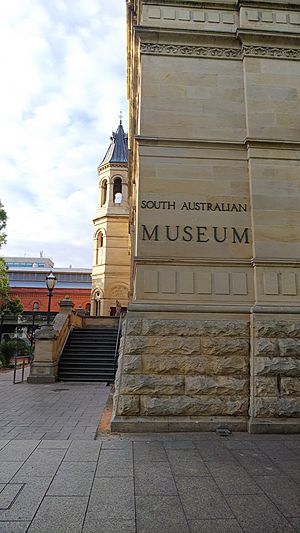South Australian Museum facts for kids
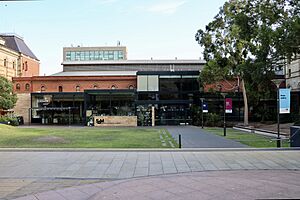
The South Australian Museum, viewed from Adelaide's cultural boulevard, North Terrace.
|
|
| Former name | South Australian Institute |
|---|---|
| Established | 1856 |
| Location | Adelaide, South Australia |
| Type | Natural history |
| Collection size | 4.84 million objects |
| Visitors | 1.1 million |
| Owner | Government of South Australia |
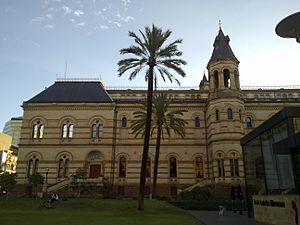
The South Australian Museum is a cool place in Adelaide, South Australia, where you can explore nature and history. It's a natural history museum and a research center that first opened in 1856. The museum is owned by the Government of South Australia. It's located in a group of buildings on North Terrace, which is a cultural area in Adelaide Parklands. There are plans to move many of its amazing Australian Aboriginal cultural items, which is the biggest collection in the world, to a new special gallery.
Contents
The Museum's Story: How It Began
Starting in the 1800s
Long ago, people tried to create places for learning and libraries in the colony. But they often struggled to find suitable buildings. In 1856, the government decided to help. They promised to build the first government-funded cultural building.
So, in 1861, the South Australian Institute was created. It included a public library and a museum. It started in a rented building while its own special building was being built. This new building was on the corner of North Terrace and Kintore Avenue.
In June 1856, a law was passed to officially create the South Australian Institute. This law put the Institute under the control of a special group called the Board of Governors. All the old library and museum items were given to this new group. The law made sure there would be both a library and a museum.
Frederick George Waterhouse became the first curator of the museum in 1859. He worked for free at first. When the new building was ready, he became the official curator until 1882. After him, Wilhelm Haacke suggested changing the name to the South Australian Museum. He also became the first Director, but he only stayed for a short time.
Growing in the 1900s
In 1939, a new law called the Museum Act made the South Australian Museum separate from the Art Gallery and Library. This is when it officially got its current name. Later, in 1997, the museum received money to create its ground floor gallery for Australian Aboriginal Cultures.
The Museum Today: 2000s and Beyond
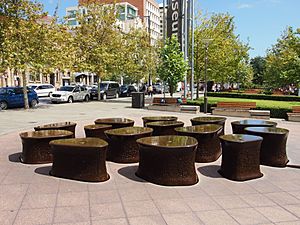
In the years after 2002, the museum got more funding. This helped them update the Pacific Cultures Gallery and create the South Australian Biodiversity Gallery.
In 2005, a cool public artwork called 14 Pieces was put in front of the museum. It was made by artists Angela and Hossein Valamanesh. This artwork uses water and looks like the bones of an ancient marine reptile called an ichthyosaur.
How the Museum is Run
Its Important Role
The museum's main job is to protect, study, and help people enjoy nature and culture. This is for everyone now and in the future. The museum's exhibits, collections, programs, and science research help us understand human cultures and the natural world. They also help people keep learning throughout their lives.
The museum wants to use its amazing collections to discover and share new knowledge. It focuses on Australian Aboriginal and Pacific cultures, as well as Earth and Life Sciences.
The museum is managed by a special board of eight people. These people are chosen by the Minister.
Recent Leaders of the Museum
In 2011, Jane Lomax-Smith became the head of the museum board. In November 2020, Kim Cheater took over as chair. After some changes were planned (which we'll talk about next), Kim Cheater resigned. Robert Saint then became the new presiding officer.
In March 2023, David Gaimster was appointed as the director, also called the CEO. However, on December 27, 2024, it was announced that David Gaimster would be stepping down. Clare Mockler is now the acting director while they look for a new permanent leader.
Changes and Plans for the Future
In February 2024, there was a plan to change how the museum worked. This plan involved changing some research and collections jobs. Many people, including museum staff and supporters, were worried about these changes. There was even a protest.
Because of the public concern, the Premier of South Australia, Peter Malinauskas, stepped in. He started a review to look at the plan. On August 28, 2024, a petition with over 10,000 signatures was given to Parliament.
Finally, on September 19, 2024, Premier Malinauskas announced that the planned changes would not happen. A new plan would be created by working together with everyone. The museum's important research and collection work would not be changed. The government also gave the museum AU$4.1 million to help develop this new plan.
Amazing Collections at the Museum
The museum has over five million objects and specimens! As of July 2025, these are grouped into several main collections:
- Australian Polar collection(s)
- Biological Sciences collection
- Humanities collection
- Library collection
- Mineral Sciences collection
- Palaeontology collection
Australian Polar Collection
This collection is all about Antarctic exploration. It used to be called the Mawson Gallery, named after Sir Douglas Mawson. In 2018, it was updated to also show items from two other South Australian explorers: John Riddoch Rymill and George Hubert Wilkins. The Mawson collection is the largest, with over 100,000 items.
Biological Sciences Collection
This collection has more than three million animal specimens! It includes the Australian Biological Tissue Collection (ABTC), which is the biggest tissue collection in the Southern Hemisphere.
As of 2016, the museum has the largest and most complete collection of marine mammal specimens in Australia. It has over 2200 items from 59 different species. The museum even has a special place near Bolivar to prepare large animal specimens.
Humanities Collection
This collection holds "the largest and most complete collection of Australian Aboriginal cultural items in the world." It has about 30,000 objects. Many of these items are being put online. This means you can see images and information about them from anywhere!
In 2016, a generous person named Margaret Davy helped fund a new job for an Indigenous curator. This was the first time the museum had a main curatorial role specifically for an Indigenous person. The first person in this role was Glenn Iseger-Pilkington.
The museum also has the biggest collection of carvings by Arrernte artist Erlikilyika, also known as Jim Kite. He lived at a remote telegraph station.
Library Collection
The Museum Library has books and journals that help with research for the museum's collections and exhibits. It has about 17,000 books, 2,300 rare books, 30,000 science journals, and 21,200 photos.
Mineral Sciences Collection
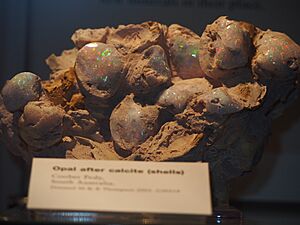
This collection has over 32,000 minerals, rocks, meteorites, and tektites from all over the world. It also has a growing collection of opals, including two very famous and valuable ones: the Virgin Rainbow and the Fire of Australia.
Palaeontology Collection
The Palaeontology collection has about 50,000 fossil specimens. These include examples of the Ediacaran biota (very early life forms), ancient sea creatures from South Australia, plant fossils, and many different animal fossils from various time periods.
Returning Ancestral Remains
The museum has a new policy to return the ancestral remains of about 4600 Old People to their traditional lands. These remains are currently stored at the museum. Some were collected by people like former Museum Director Edward C. Stirling. However, most were found because of land clearing, building projects, or by members of the public.
In 2018, Anna Russo was appointed as an Aboriginal heritage and repatriation manager. This shows the museum's commitment to returning these remains. Kaurna elder Jeffrey Newchurch had been working for years to make this happen.
On August 1, 2019, the remains of 11 Kaurna people were laid to rest in a special ceremony. The museum is working closely with the Kaurna people to return their ancestors. They also want to teach the community about how important this is to Aboriginal people. The museum continues to receive more remains and is looking for a good solution, like a memorial park, to honor them.
Cool Exhibitions You Might See
Waterhouse Art Prize
The annual Waterhouse Natural Science Art Prize is a big art competition in Australia. It's named after the museum's first curator. Exhibitions of the amazing artwork entered in this competition are held at the museum.
Traversing Antarctica: the Australian Experience (2013–2014)
This exhibition showed rare items and displays about Australia's history and science in Antarctica. It ran from December 2013 to March 2014.
Shimmer (2015)
This was a special exhibition that worked with JamFactory and Tarnanthi. Tarnanthi is a national event that shows off Indigenous Australian art and culture. This exhibition was on from October to November 2015.
Ngurra: Home in the Ngaanyatjarra Lands (2017–2018)
Ngurra is a word that means home, country, camp, birthplace, and belonging. This exhibition showed the amazing creativity of the Ngaanyatjarra people from Western Australia. It ran from October 2017 to January 2018.
Yurtu Ardla (2019)
Yurtu Ardla means wood in the Nukunu and Adnyamathanha languages. This exhibition showed beautiful wood carvings. It helped bring back old Nukunu carving traditions. The exhibition included newly made items like piti (baskets), thiparra (shields), and wadna (boomerangs). It ran from March to June 2019.
Treasures of the Viking Age: The Galloway Hoard (2025)
This exhibition features an amazing collection of objects from the Galloway Hoard. These are rare and unique items from the Viking Age that were buried around 900 AD in Scotland and found in 2014. This is the first time this exhibition is shown outside the UK. It is at the South Australian Museum from February 8 to July 27, 2025.
People Connected to the Museum
Historical Figures
- Edgar Ravenswood Waite: A zoologist who was Director of the SA Museum from 1914 to 1928.
- Amandus Heinrich Christian Zietz: A zoologist and assistant director from 1900 to 1910.
- Sir Douglas Mawson: A famous Antarctic explorer and geologist. He was an Honorary Curator of Minerals at the museum from 1907 to 1958.
Current Experts
- Philip Jones: A senior curator and historian.
- Jared Thomas: A Nukunu man and award-winning author. He is the William and Margaret Geary Curator of Aboriginal and Torres Strait Islander Art and Material Culture.
- Jim Gehling: A palaeontologist known for his research on early multicellular life.
- Chris H.S. Watts: An entomologist who has named over 280 types of insects.
Past Directors
Here are some of the people who have led the South Australian Museum:
| Start | End | Name |
|---|---|---|
| 1861 | Feb 1882 | Frederick George Waterhouse |
| 1883 | 1885 | Johann Wilhelm Haacke |
| 1889 | 1912 | Edward Charles Stirling |
| 1913 | 1928 | Edgar Ravenswood Waite |
| 1931 | 1960 | Herbert Mathew Hale |
| 1962 | 1968 | William Peter Crowcroft |
| 1968 | 1972 | W. Grant Inglis |
| 1973 | 1982 | Dr John Kynaston Ling |
| 1984 | 1993 | Lester D Russell |
| 1993 | 1998 | Dr John Christopher Anderson |
| 1999 | 2006 | Prof. Timothy Fridtjof Flannery |
| 2007 | 2013 | Prof. Suzanne Miller |
| 2014 | 2022 | Brian Leslie Oldman |
| 2023 | 2024 | Dr David Gaimster |
Working Together: Partnerships and Sponsors
The museum works with many partners and sponsors. This helps them put on events, do research, and create new exhibits.
They partner with universities like the University of Adelaide and Flinders University. They also work with places like the Botanic Gardens of South Australia and CSIRO.
Companies like BHP, Beach Energy, and Santos also support the museum.
New Aboriginal Cultural Centre
As of 2019, the South Australian government planned to create a new gallery for Aboriginal art and culture. This new center would be at the old Royal Adelaide Hospital site, now called Lot Fourteen. The idea is to keep the natural history museum at its current location and have a separate, special place for Aboriginal culture.
In early 2019, discussions began with many groups, including Aboriginal communities. An update in February 2020 said the new gallery was planned to be finished by 2023. However, these plans have been reviewed. A decision on the Tarrkarri Aboriginal centre was postponed until 2024. The government is looking for more funding from generous donors. A group of experts suggested in April 2023 that between $400 million to $600 million should be spent to make Tarrkarri a truly important international center.
Images for kids
-
Precious opal replacing Ichthyosaur backbone
-
Display panel for the opalised Addyman Plesiosaur fossil from Andamooka
-
Display of the opalised Addyman Plesiosaur fossil from Andamooka
-
Rear view of the opalised Addyman Plesiosaur fossil from Andamooka
See also


